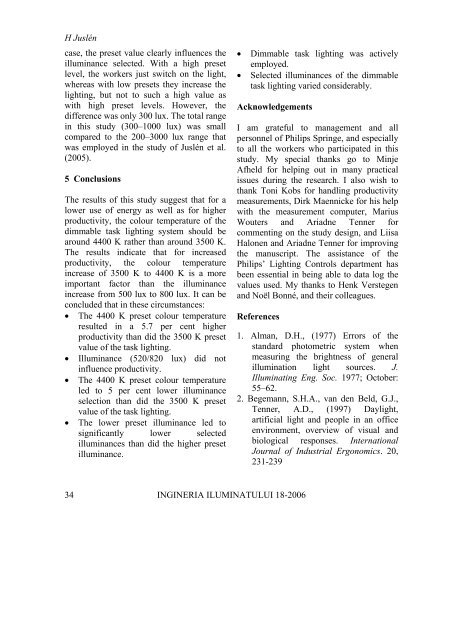This issue is sponsored by the Philips Romania, Lighting Division
This issue is sponsored by the Philips Romania, Lighting Division
This issue is sponsored by the Philips Romania, Lighting Division
You also want an ePaper? Increase the reach of your titles
YUMPU automatically turns print PDFs into web optimized ePapers that Google loves.
H Juslén<br />
case, <strong>the</strong> preset value clearly influences <strong>the</strong><br />
illuminance selected. With a high preset<br />
level, <strong>the</strong> workers just switch on <strong>the</strong> light,<br />
whereas with low presets <strong>the</strong>y increase <strong>the</strong><br />
lighting, but not to such a high value as<br />
with high preset levels. However, <strong>the</strong><br />
difference was only 300 lux. The total range<br />
in th<strong>is</strong> study (300–1000 lux) was small<br />
compared to <strong>the</strong> 200–3000 lux range that<br />
was employed in <strong>the</strong> study of Juslén et al.<br />
(2005).<br />
5 Conclusions<br />
The<br />
results of th<strong>is</strong> study suggest that for a<br />
lower use of energy as well as for higher<br />
productivity, <strong>the</strong> colour temperature of <strong>the</strong><br />
dimmable task lighting system should be<br />
around 4400 K ra<strong>the</strong>r than around 3500 K.<br />
The results indicate that for increased<br />
productivity, <strong>the</strong> colour temperature<br />
increase of 3500 K to 4400 K <strong>is</strong> a more<br />
important factor than <strong>the</strong> illuminance<br />
increase from 500 lux to 800 lux. It can be<br />
concluded that in <strong>the</strong>se circumstances:<br />
• The 4400 K preset colour temperature<br />
resulted in a 5.7 per cent higher<br />
productivity than did <strong>the</strong> 3500 K preset<br />
value of <strong>the</strong> task lighting.<br />
• Illuminance (520/820 lux)<br />
did not<br />
influence productivity.<br />
• The 4400 K preset colour<br />
temperature<br />
led to 5 per cent lower illuminance<br />
selection than did <strong>the</strong> 3500 K preset<br />
value of <strong>the</strong> task lighting.<br />
• The lower preset illuminance led to<br />
significantly lower selected<br />
illuminances than did <strong>the</strong> higher preset<br />
illuminance.<br />
34<br />
• Dimmable task lighting was actively<br />
employed.<br />
• Selected illuminances of <strong>the</strong> dimmable<br />
task lighting varied considerably.<br />
Acknowledgements<br />
I am grateful to management and all<br />
personnel of <strong>Philips</strong> Springe, and especially<br />
to all <strong>the</strong> workers who participated in th<strong>is</strong><br />
study. My special thanks go to Minje<br />
Afheld for helping out in many practical<br />
<strong><strong>is</strong>sue</strong>s during <strong>the</strong> research. I also w<strong>is</strong>h to<br />
thank Toni Kobs for handling productivity<br />
measurements, Dirk Maennicke for h<strong>is</strong> help<br />
with <strong>the</strong> measurement computer, Marius<br />
Wouters and Ariadne Tenner for<br />
commenting on <strong>the</strong> study design, and Li<strong>is</strong>a<br />
Halonen and Ariadne Tenner for improving<br />
<strong>the</strong> manuscript. The ass<strong>is</strong>tance of <strong>the</strong><br />
<strong>Philips</strong>’ <strong>Lighting</strong> Controls department has<br />
been essential in being able to data log <strong>the</strong><br />
values used. My thanks to Henk Verstegen<br />
and Noël Bonné, and <strong>the</strong>ir colleagues.<br />
References<br />
INGINERIA ILUMINATULUI 18-2006<br />
1. Alman, D.H., (1977) Errors of <strong>the</strong><br />
standard photometric system when<br />
measuring <strong>the</strong> brightness of general<br />
illumination light sources. J.<br />
Illuminating Eng. Soc. 1977; October:<br />
55–62.<br />
2. Begemann, S.H.A., van den Beld, G.J.,<br />
Tenner, A.D., (1997) Daylight,<br />
artificial light and people in an office<br />
environment, overview of v<strong>is</strong>ual and<br />
biological responses. International<br />
Journal of Industrial Ergonomics. 20,<br />
231-239
















